|
Botany of Paddy
Rice is one of the most important food crops in the world and it is the staple food for over 2.7 billion people. In India,
area under rice is 44.6 m ha with total output of 80 million tonnes (paddy) with an average productivity of 1855 kg/ha. It is grown
in almost all the states. West Bengal, Uttar Pradesh, Madhya Pradesh, Bihar, Orissa, Andhra Pradesh, Assam, Tamilnadu,
Kerala, Punjab, Maharashtra and Karnataka are major rice growing states and contribute to total 92% of area and production.
Kingdom: Plantae
Division: Magnoliophyta
Class: Liliopsida
Order: Cyperales
Family: Gramineae
Genus: Oryza
Species: Sativa
Subspecies: Indica
Common name: Paddy in English, Nel in Tamil, Nellu in Malayalam, Bhatta in Kannada. |
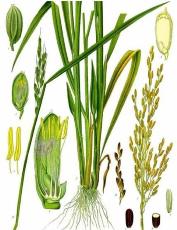 |
Top
| |
Root |
 |
Rice form a fibrous root system consisting of seminal, nodal and lateral roots.
- As the rice grain germinates, the radical pierces its way out through the coleorhizae and the enveloping glume and forms the seminal root.
- Lateral roots are formed from the seminal root.
- As the seedlings begin to grow, adventitious roots arise from the basal nodes. When seedlings are pulled out, most of the roots get torn off but very soon fresh roots develop.
- The root system in rice varies much between the different varieties.
- Root development is promoted by organic manures and phosphatic manures. Clayey soil seems to be ideal for the normal development of the roots.
- Nodal roots develop on the higher nodes and help the plant to absorb the food material from the surrounding water.
|
Top
| Culm or Stem |
|
- The culm, or jointed stem of the rice, is made up of a series of nodes and internodes
- The stem of rice popularly known as the haulm or the culm, is generally erect, cylindrical, hollow at the internodes and solid at the nodes.
- The number and length of internodes vary with the different varieties. There may be ten to twenty internodes.
- In deep water rice varieties and in floating types, the culms have generally very long internodes.
|
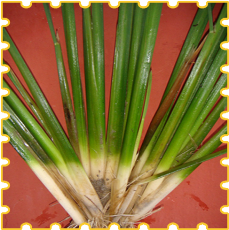
|
Top
| |
Tillers |
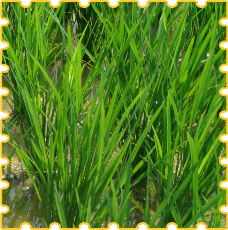
|
- The node is the solid portion of the culm.
- The node or nodal region bears a leaf and a bud.
- The bud is attached to the upper portion of the node and is enclosed by the leaf sheath.
- The bud may give rise to a leaf or a tiller.
- Early tillers arise from the main culm in an alternate pattern.
- Primary tillers originate from the lowermost nodes and give rise to secondary tillers.
- Secondary tillers produce tertiary tillers.
- Each tiller is an independent plant.
- The maximum production of tillers is generally attained thirty to forty days after transplanting.
|
Top
| Leaf |
|
- The node or nodal region of the culm will bear a leaf.
- Leaves are borne alternately on the culm in opposite directions. One leaf is produced at each node. Varieties differ in the number of leaves produced.
- The topmost leaf below the panicle is the flag leaf. The flag leaf contributes largely to the filling of grains because it supplies photosynthetic products, mainly to the panicle
- The leaf sheath and leaf blade are continuous.
- A circular collar joins the leaf blade and the leaf sheath.
- The leaf sheath is wrapped around the culm above the node.
- The swelling at the base of the leaf sheath,just above the node,is the sheath pulvinus. It is sometimes incorrectly referred to as the node.
- Leaf blades are generally flat. Varieties differ in blade length, width, thickness, area, shape, color, angle and pubescence.
- With many parallel veins on the upper surface of the leaf, the underside of the leaf blade is smooth with a prominent ridge in the middle; the midrib
- Most leaves possess small, paired ear-like appendages on either side of the base of the blade - called auricles.
- Auricles may not be present on older leaves. Another leaf appendage is the ligule, a papery membrane at the inside juncture between the leaf sheath and the blade
- It can have either a smooth or hair-like surface.
- The length, color, and shape of the ligule differ according to variety.
|

|
Top
| |
Panicle |
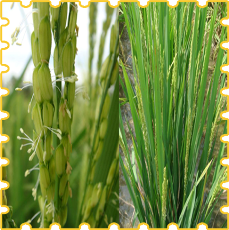
|
- The terminal component of the rice tiller is an inflorescence called as panicle. The inflorescence or panicle is borne on the uppermost internode of the culm. The panicle bears rice spikelets, which develop into grains.
- The panicle base often appears as a hair like ring and is used as a dividing point in measuring culm and panicle length. The panicle base is often called the neck.
- The panicle axis is continuous and hollow except at the nodes where branches are borne.
- The swellings at the panicle axis where the branches are borne are referred to as the panicle pulvinus.
- Each node on the main panicle axis gives rise to primary branches which in turn bears secondary branches. Primary branches may be arranged singly or in pairs.
- The panicles bear spikelets, most of which develop into grains. These spikelets are borne on the primary and secondary branches. The spikelet is the basic unit of the inflorescence and panicle. It consists of the pedicel and the floret .
- The floret is borne on the pedicel.
- The rudimentary glumes are the laterally enlarged, cup like apex of the pedicel. The rudimentary glumes are the lowermost parts of the spikelet. During threshing, the rudimentary glumes are separated from the rest of the spikelet.
- The sterile lemmas are small, bractlike projections attached to the floret. The rachillae is a small axis that bears the single floret. It is between the sterile lemmas and the floret
|
Top
| Spikelets |
|
- The spikelets are carried on small rachillae at the ends of the branches of the panicle.
- The spikelet in rice is single flowered enclosed by the lemma and palea.
- There are six stamens, in two whorls of three each, the filaments being very slender and delicate and having sudden exertion of growth at the time of anthesis.
- The anthere are linear. The pistil has a single ovary, two styles each with a plumose and laterally exerted stigma ovary, two styles each with a plumose and laterally exerted stigma of different shades of purple.
- The overy is tricarpellary, single celled, single ovuled and with basal placentation.
- In most cases the plumose stigmas are dusted with pollen when they emerge out as the dehiscence of the anthers takes place in many varieties just at the time of opening.
- Though self-pollination is the rule, natural cross-pollination also occurs, varying from 0.1 to 4.0 percent.
|
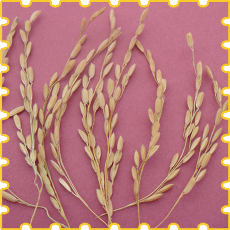
|
Top
| |
Grain |
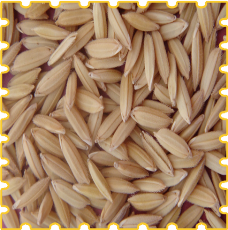
|
- The ovule after fertilization develops into the seed with its coats completely fused together with the developing ovary wall or pericarp.
- Pericarp of fruit coat: The pericarp is made up of distinct layers of quadrangular cells which form the Epicarp. These cells have slight thickening and are followed by cells which are much compressed and form the Mesocarp consisting of two or three layers. The Endocarp is a single layer of tube cells. The color in the rice grain is found in the pericarp layer in the mature stage.
- The seed coats: Due to the pressure brought out by the developing seed on the pericarp, the testa and tegmen become much pressed down and out of shape. A few layers of such cells below the pericarp can be diagnosed as the integuments of seed coats.
- The aleurone layer: A prominent layer of rectangular cells which contain protein lies next to the seed coats. This layer is known as the aleurone layer. The layer in rice is not coloured unlike in case of maize.
- The endosperm: the entire mass of tissue below the aleurone layer is made up of cells which contain plenty of starch grains and these form the endosperm.
- The embryo: the scutellum has an upper free part which has a fleshy projection known as the ventral scale. Below this upper ventral scale and almost at the middle of the free part there is another outgrowth which can be called as the inner ventral scale and theis inner ventral scale is peculiar to rice embryos only.
|
Top
Climate
| Climate and Soil requirement |
Rice is a crop of tropical climate. However, it is also grown successfully in humid to sub-humid regions under subtropical and temperate climate. Rice is cultivated in almost all types of soils with varying productivity. Under high temperature, high
humidity with sufficient rainfall and irrigation facilities, rice can be grown in any type of soil. The major soil groups where rice
is grown are riverine alluvium, red-yellow, red loamy, hill and sub-montane, Terai, laterite, costal alluvium, red sandy, mixed
red, black, medium and shallow black soils.
Top
- Rice cultivation in the world extends from 39°S latitude (Australia) to 45°N latitude (Japan) and 50°N latitude (China).
- Most extensive rice growing areas are within 45°N of the equator.
- In India rice is grown under widely varying conditions of altitude and climate.
- Rice cultivation in India extends from 8 to 35°N latitude and from sea level to as high as 3000 metres elevation.
Top
- Rice being a tropical and sub-tropical plant, requires a fairly high temperature, ranging from 20° to 40°C.
- The optimum temperature of 30°C during day time and 20°C during night time seems to be more favorable for the
development and growth of rice crop.
Top
Growth stages and optimum temperature ranges
| Stage |
Optimum temperature (°C) |
| Germination |
20-35 |
| Seedling emergence |
25-30 |
| Rooting |
25-28 |
| Leaf elongation |
31 |
| Tillering |
25-31 |
| Panicle initiation |
15-30 |
| Anthesis |
30-33 |
| Ripening |
20-25 |
Top
- Sunlight is very essential for the development and growth of the plants.
- The yield of rice is influenced by the solar radiation particularly during the last 35 to 45 days of its ripening period.
- Bright sunshine with low temperature during ripening period of the crop helps in the development of in the grains.
- 300 cal /cm-2 /day is minimum required.
- Better yield is obtained when the Solar Radiation is 500-700 cal /cm-2 /day.
Top
- Rainfall has direct impact on deciding the ecosystem.
- Rice requires abundant rainfall, ranging from 150 cm to 200 cm.
- Paddy withstands water logged conditions.
- Grown as low-land crop with standing water as well as upland crop under rainfed conditions.
- Requires a rainfall of 125 cm during vegetative stage.
- Heavy downpour at anthesis and flowering leads to sterility
- No standing water at ripening stage.
Top
- Relative humidity (RH) directly influences the water relations of plant and indirectly affects leaf growth,
photosynthesis, pollination, occurrence of diseases and finally economic yield.
- The incidence of insect pests and diseases is high under high humidity conditions.
- High RH favours easy germination of fungal spores on plant leaves.
- Majority of pest and diseases are commonly seen during rainy season while aphids, thrips, scales,
mealy bugs and mites are relatively more severe during summer.
- Blast disease of rice is common in winter season.
- The incidence of gall midge is common during kharif as compared to rabi due to high RH requirement of the
pest particularly in the early growth stages.
- Moderate Rainfall, Relative humidity of around 80% and a wide range of atmospheric temperature of 20-33°c
appear to be highly conducive to the Brown plant hopper.
Top
- Wind is normally unimportant factor in rice production.
- A light wind is said to be beneficial as it stirs air and transports CO2 to the leaf canopy.
- Very strong winds do occur during cyclones and lead to severe damage.
- During pollination, strong wind may induce sterility and increase the number of abortive endosperms.
- Strong wind during flowering phase may not be conducive for rice crop.
- High wind speed during flowering may cause pollen dehydration and consequent spikelet sterility.
Top
| Area, Production and yield of paddy in the world |
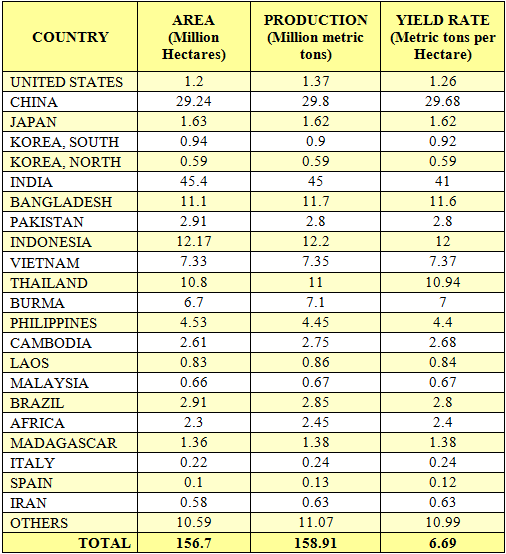
Source : www.indiaagristat.com 2008-09 data |
| Area, Production and yield of paddy in the major states of India |

Source : www.indiaagristat.com 2009-10 data |
| Area, Production and yield of paddy in Tamil Nadu |
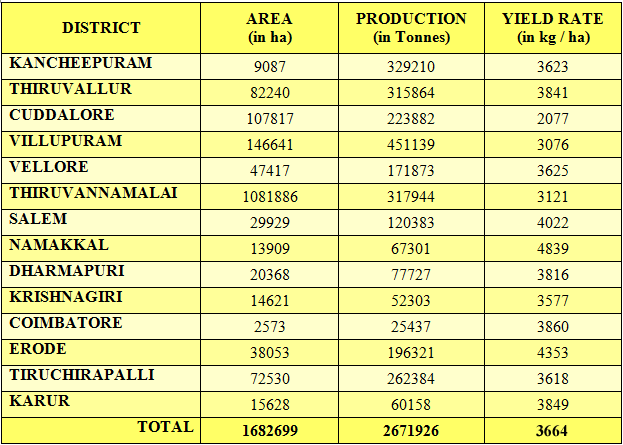

Source : www.indiaagristat.com 2008-09 data
|
| Area, Production and yield of paddy in Kerala |
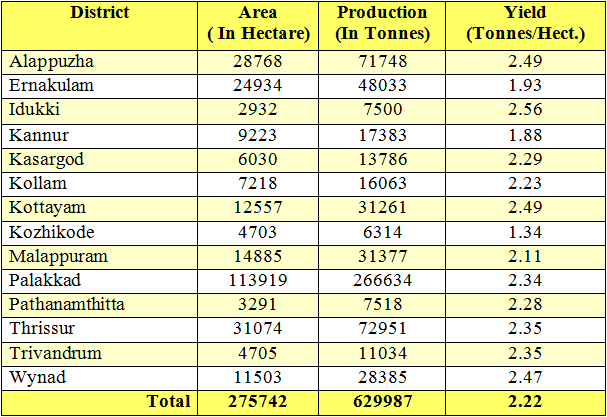
Source : www.indiaagristat.com 2005-06 data |
| Area, Production and yield of paddy in Karnataka |
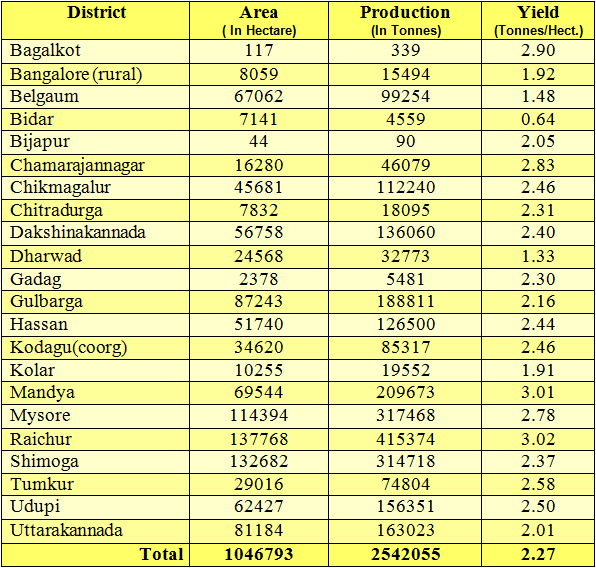
Source : www.indiaagristat.com 2006-07 data |
| Area, Production and yield of paddy in India based on rice ecosystem |

Source : Indian Farming, Oct 2006 - Special Issue |
|





























